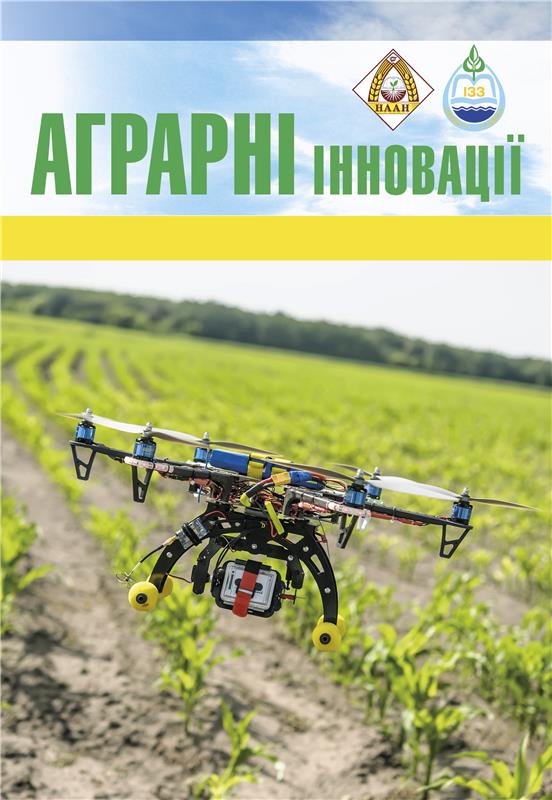FEATURES OF MICROCLONAL PROPAGATION OF SAFFRON SEEDS (CROCUS SATIVUS L.)
Abstract
Propagation of saffron in vitro involves, first of all, obtaining healthy planting material. Purpose. To optimize the processes of saffron seed propagation using the in vitro method on various modifications of the nutrient medium; to investigate the influence of the medium composition on the growth of biomass and the formation of saffron mini corms.Methods. Visual – for conducting phenological observations; measurement and weight – for determining biometric indicators and productivity; chemical – for studying qualitative indicators; mathematical and statistical – for establishing the reliability of experiments and studying correlation dependencies. The biotechnological method of tissue culture (in vitro) with crocus seed explants was carried out in the microclonal laboratory of the Institute of Climate-Smart Agriculture of the NAAS of Ukraine. Results. Saffron seed plants (Crocus sativus L.) due to their genotypic characteristics are not capable of sexual reproduction, this is possible only by planting corms. At the same time, their repeated use leads to significant infection and a decrease in the quality of planting material. Using the in vitro method, new uninfected saffron plants were induced from saffron explants – mini corms, suitable for further propagation. For microcloning, Murashige Skoog (MS) agar medium supplemented with exogenous growth regulators with different hormonal composition was used, according to the experimental scheme.Conclusions. The results of the studies showed that saffron (Crocus sativus L.) is successfully cultivated in vitro.Excellent results were obtained for germination and establishment of saffron explants, which during the vegetation period formed full-fledged microcorms, suitable for further propagation. In turn, the quality of cultivation largely depended on the nature of phytohormones, their concentration and ratio in the nutrient medium.
References
2. Analysis of Global Saffron (Crocus sativus L.) Research Trends Between 2000-2023 / Tosan M., Siuki A. H., Sanghari M., Moghaddam P. R. Saffron Agronomy & Technology. 2024. 1(2). Р. 115-138. DOI:10.22048/ jsat.2024.443037.1524.
3. Yang W., Qiu X., Wu Q. et al. Active constituents of saffron (Crocus sativus L.) and their prospects in treating neurodegenerative diseases. Experimental and Therapeutic Medicine. 2023. 25(5). https://doi. org/10.3892/etm.2023.11934.
4. Mir R. A., Tyagi A., Hussain S. J., Almalki M. A. Saffron, a Potential Bridge between Nutrition and Disease Therapeutics: Global Health Challenges and Therapeutic Opportunities. 2024. Plants. 3(11):1467 DOI: 10.3390/ plants13111467.
5. Pandita D. Saffron (Crocus sativus L.): phytochemistry, therapeutic significance and omicsbased biology. Medicinal and Aromatic Plants. 2021. P. 325-396. https://doi.org/10.1016/B978-0- 12-819590-1.00014-8.
6. Cardoso J. C., BS de Oliveira M. E., CI Cardoso F. Advances and challenges on the in vitro production of secondary metabolites from medicinal plants. Horticultura Brasileira, 2019. (2), p. 124-132. DOI: 10.1590/S0102-053620190201.
7. 7.Maggi M. A., Bisti S., Picco C. Saffron: Chemical Composition and Neuroprotective Activity. 2020 р.; 25 (23): 5618. doi: 10.3390/molecules25235618.
8. Тканинні культури лікарських рослин Карпат для збереження біорізноманіття / Загородня Д. С., Петенко І. Б., Тепла Ю. І., Петріна Р. О. Всеукраїнська науково-практична конференція «Біологічні досягнення», 21-23 березня 2020 р. м. Житомир. С. 358-360.
9. Сатарова Т. М., Абраімова О. Є., Вінніков А. І., Черенков А. В. Біотехнологія рослин: навчальний посібник. Дніпропетровськ: Адверта, 2016. 136 с.
10. Рибальченко А. М., Криворучко Л. М. Мікроклональне розмноження в культурі in vitro: можливості та переваги використання. Український журнал природничих наук. 2024. № 10. с. 155-158. DOI: https://doi. org/10.32782/naturaljournal.10.2024.14.
11. Манушкіна Т. М. Біотехнологія в рослинництві: курс лекцій. Миколаїв: МНАУ, 2016. 51 с.
12. Статистичний аналіз результатів польових дослідів у землеробстві / Ушкаренко В. О., Вожегова Р. А., Голобородько С. П., Коковіхін С. В. Херсон: Айлант, 2013. 378 с.
13. Propagation of Saffron (Crocus sativus L.) through tissue culture: a review / Tahiri A., Mazri M. A., Youssef K., Naima A. A. Journal of Horticulture and Biotechnology. 2022. 98 (1). Р. 10-30. DOI: 10.1080/14620316.2022.2078233
14. Halim R., Guler B., Gurel A., Bayraktar M. (). In vitro callus induction of saffron (Crocus Sativus L.). International Journal of Innovative Science and Research Technology. 2018. Volume 3, Issue 11. Pp. 696-700. https://www.researchgate.net/publication/334194105_ In_Vitro_Callus_Induction_of_Saffron_Crocus_ Sativus_L






